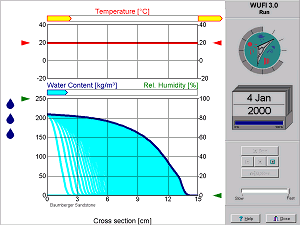FAQ:General:SimulationofAbsorptionExperiment
(14): Simulation of Absorption Experiment
WUFI gives me the option to estimate the liquid transport coefficients Dws from the water absorption coefficient. How can I check how good this estimate is?
You can check the estimated Dws or determine an unknown water absorption coefficient from known Dws by simulating a water absorption experiment.
Define an initially dry layer consisting of the material in question, let it rain on the surface (with a higher rain load than the layer can absorb to be sure that no insufficient rain load is limiting the water uptake) and look at the amount of water absorbed after e.g. 100 or 200 hours.
This may be done with a one-line *.KLI-file such as:
| [h: | rain: | rad: | t_ext: | RH_ext: | t_int: | RH_int:] |
| 500 | 1000 | 0 | 20 | 1 | 20 | 0 |
The number of hours entered for the duration of this one-line climate file does not matter since WUFI re-starts reading from the beginning of the climate file if the simulation period extends beyond the end of the climate file.
Set the vapor diffusion thickness of the interior surface to a very high value to prevent vapor transport through that surface.
You should perform a few test calculations in order to find a suitable thickness of the test specimen which assures that the moisture front traverses most of the specimen (in order to make the most efficient use of the numerical grid) but not all of it.
